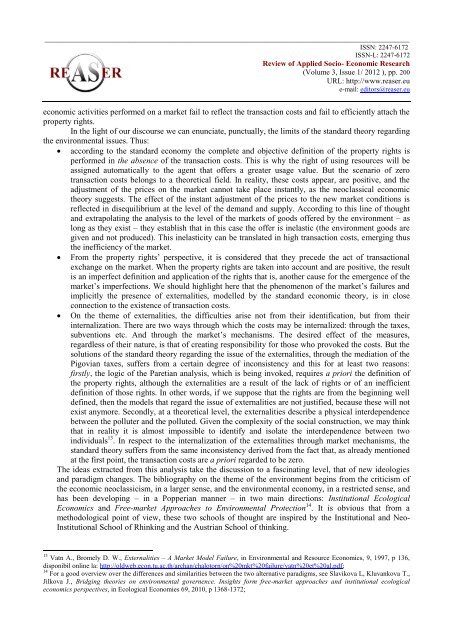Volume 3, ISSUE1/2012 - Review of Applied Socio-Economic ...
Volume 3, ISSUE1/2012 - Review of Applied Socio-Economic ...
Volume 3, ISSUE1/2012 - Review of Applied Socio-Economic ...
You also want an ePaper? Increase the reach of your titles
YUMPU automatically turns print PDFs into web optimized ePapers that Google loves.
________________________________________________________________________________________________<br />
ISSN: 2247-6172<br />
ISSN-L: 2247-6172<br />
<strong>Review</strong> <strong>of</strong> <strong>Applied</strong> <strong>Socio</strong>- <strong>Economic</strong> Research<br />
(<strong>Volume</strong> 3, Issue 1/ <strong>2012</strong> ), pp. 200<br />
URL: http://www.reaser.eu<br />
e-mail: editors@reaser.eu<br />
economic activities performed on a market fail to reflect the transaction costs and fail to efficiently attach the<br />
property rights.<br />
In the light <strong>of</strong> our discourse we can enunciate, punctually, the limits <strong>of</strong> the standard theory regarding<br />
the environmental issues. Thus:<br />
according to the standard economy the complete and objective definition <strong>of</strong> the property rights is<br />
performed in the absence <strong>of</strong> the transaction costs. This is why the right <strong>of</strong> using resources will be<br />
assigned automatically to the agent that <strong>of</strong>fers a greater usage value. But the scenario <strong>of</strong> zero<br />
transaction costs belongs to a theoretical field. In reality, these costs appear, are positive, and the<br />
adjustment <strong>of</strong> the prices on the market cannot take place instantly, as the neoclassical economic<br />
theory suggests. The effect <strong>of</strong> the instant adjustment <strong>of</strong> the prices to the new market conditions is<br />
reflected in disequilibrium at the level <strong>of</strong> the demand and supply. According to this line <strong>of</strong> thought<br />
and extrapolating the analysis to the level <strong>of</strong> the markets <strong>of</strong> goods <strong>of</strong>fered by the environment – as<br />
long as they exist – they establish that in this case the <strong>of</strong>fer is inelastic (the environment goods are<br />
given and not produced). This inelasticity can be translated in high transaction costs, emerging thus<br />
the inefficiency <strong>of</strong> the market.<br />
From the property rights’ perspective, it is considered that they precede the act <strong>of</strong> transactional<br />
exchange on the market. When the property rights are taken into account and are positive, the result<br />
is an imperfect definition and application <strong>of</strong> the rights that is, another cause for the emergence <strong>of</strong> the<br />
market’s imperfections. We should highlight here that the phenomenon <strong>of</strong> the market’s failures and<br />
implicitly the presence <strong>of</strong> externalities, modelled by the standard economic theory, is in close<br />
connection to the existence <strong>of</strong> transaction costs.<br />
<br />
On the theme <strong>of</strong> externalities, the difficulties arise not from their identification, but from their<br />
internalization. There are two ways through which the costs may be internalized: through the taxes,<br />
subventions etc. And through the market’s mechanisms. The desired effect <strong>of</strong> the measures,<br />
regardless <strong>of</strong> their nature, is that <strong>of</strong> creating responsibility for those who provoked the costs. But the<br />
solutions <strong>of</strong> the standard theory regarding the issue <strong>of</strong> the externalities, through the mediation <strong>of</strong> the<br />
Pigovian taxes, suffers from a certain degree <strong>of</strong> inconsistency and this for at least two reasons:<br />
firstly, the logic <strong>of</strong> the Paretian analysis, which is being invoked, requires a priori the definition <strong>of</strong><br />
the property rights, although the externalities are a result <strong>of</strong> the lack <strong>of</strong> rights or <strong>of</strong> an inefficient<br />
definition <strong>of</strong> those rights. In other words, if we suppose that the rights are from the beginning well<br />
defined, then the models that regard the issue <strong>of</strong> externalities are not justified, because these will not<br />
exist anymore. Secondly, at a theoretical level, the externalities describe a physical interdependence<br />
between the polluter and the polluted. Given the complexity <strong>of</strong> the social construction, we may think<br />
that in reality it is almost impossible to identify and isolate the interdependence between two<br />
individuals 13 . In respect to the internalization <strong>of</strong> the externalities through market mechanisms, the<br />
standard theory suffers from the same inconsistency derived from the fact that, as already mentioned<br />
at the first point, the transaction costs are a priori regarded to be zero.<br />
The ideas extracted from this analysis take the discussion to a fascinating level, that <strong>of</strong> new ideologies<br />
and paradigm changes. The bibliography on the theme <strong>of</strong> the environment begins from the criticism <strong>of</strong><br />
the economic neoclassicism, in a larger sense, and the environmental economy, in a restricted sense, and<br />
has been developing – in a Popperian manner – in two main directions: Institutional Ecological<br />
<strong>Economic</strong>s and Free-market Approaches to Environmental Protection 14 . It is obvious that from a<br />
methodological point <strong>of</strong> view, these two schools <strong>of</strong> thought are inspired by the Institutional and Neo-<br />
Institutional School <strong>of</strong> Rhinking and the Austrian School <strong>of</strong> thinking.<br />
13 Vatn A., Bromely D. W., Externalities – A Market Model Failure, in Environmental and Resource <strong>Economic</strong>s, 9, 1997, p 136,<br />
disponibil online la: http://oldweb.econ.tu.ac.th/archan/chalotorn/on%20mkt%20failure/vatn%20et%20al.pdf;<br />
14 For a good overview over the differences and similarities between the two alternative paradigms, see Slavikova L, Kluvankova T.,<br />
Jilkova J., Bridging theories on environmental governence. Insights form free-market approaches and institutional ecological<br />
economics perspectives, in Ecological Economies 69, 2010, p 1368-1372;








